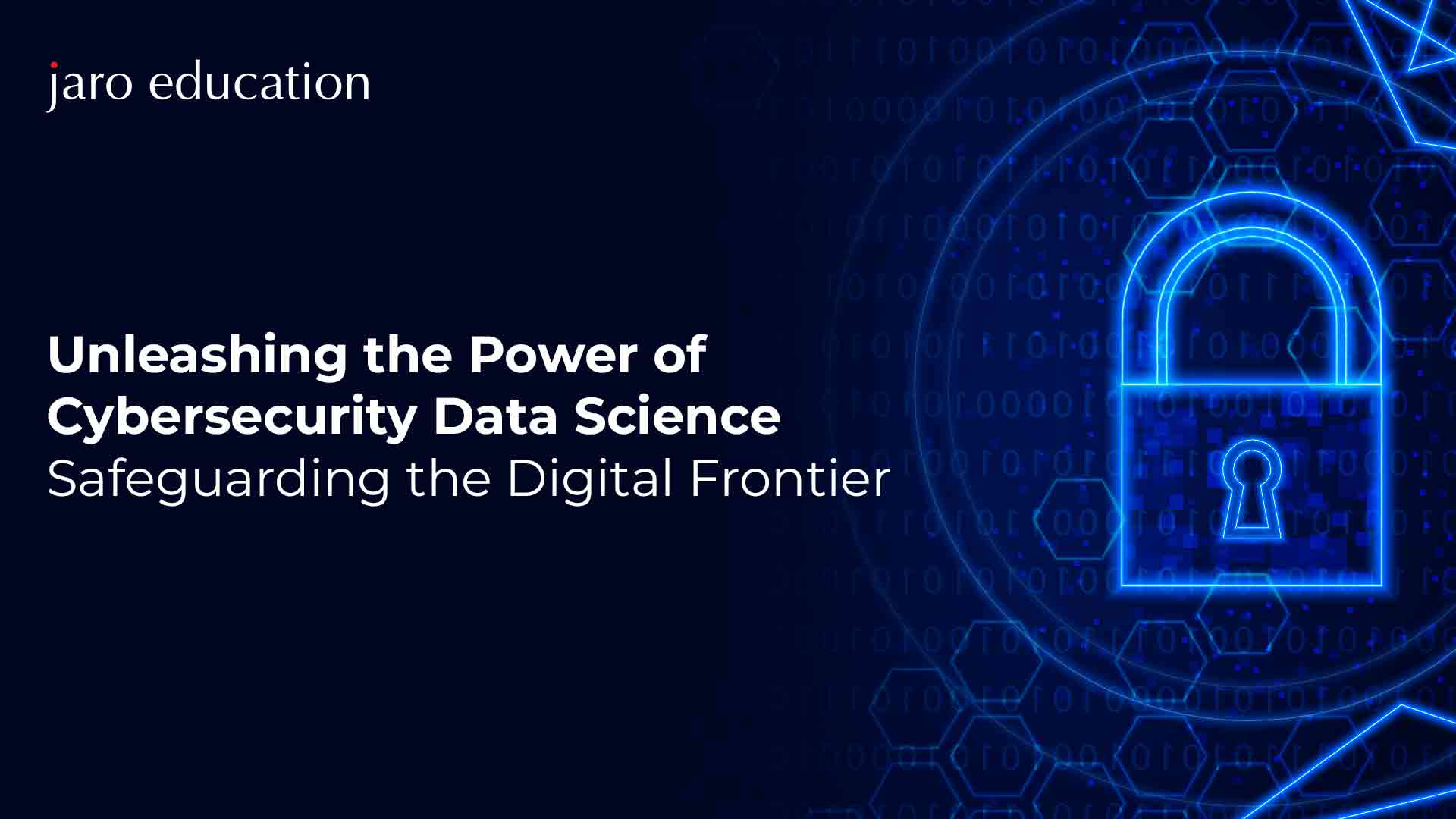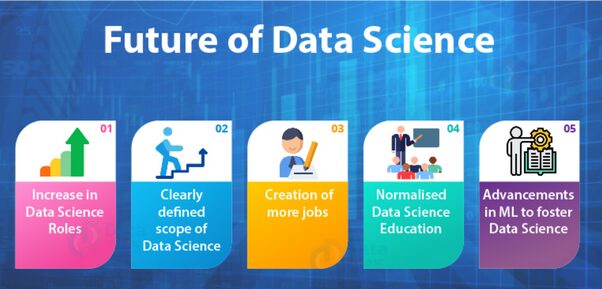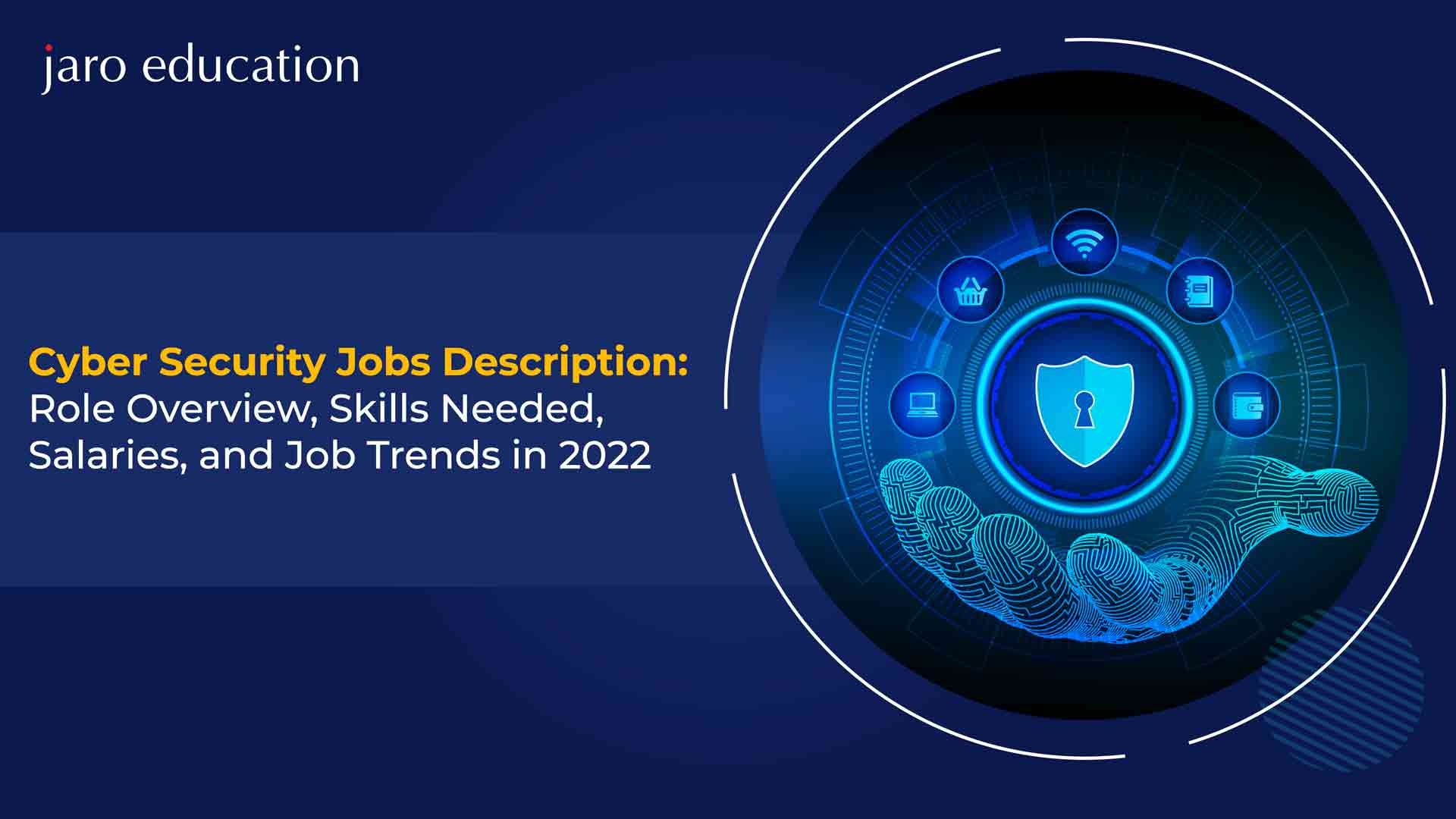Unleashing the Power of Cybersecurity Data Science: Safeguarding the Digital Frontier
Table of Contents

- jaro education
- 21, February 2024
- 2:00 pm
Millions of terabytes of data are generated daily and the amount is rising every year. And with this hike, the world is witnessing an increased number of cybersecurity attacks. Hacking and system penetration threats have been growing increasingly in recent times, placing a vast quantity of private data in danger. The reason for these attacks is a lack of monitoring and adequate protection. However, the speed at which we generate data makes it hard for even the largest organisations to securely manage data.
When a large amount of data is collected, cybersecurity data science provides a ray of hope. Data science, with its capacity to handle enormous volumes of data in a short period of time, it helps organisations forecast and increase their defence against cyberattacks. Since most businesses these days have their own websites, it is important that they have an SSL certificate that will ensure security from attackers. Let us now understand the role of data science in cybersecurity.
What is Data Science in Cybersecurity?
Data Science for Cyber Security has been an essential shift in preventing fraudulent activity. It employs Machine Learning techniques on historical data to forecast the possibility of an incursion or assault. It entails creating algorithms to deduce patterns from prior assaults and warning about the trustworthiness of the system in use.
For example, detect unauthorised entry at an institution. The AI model would only provide access to pre-registered people based on their credentials, and it would analyse their activities to ensure that no action occurred outside authorization. All of these actions are taken to avoid data breaches or abuse of information.
What Role Does Data Science Play in Cybersecurity?
Here are the varied roles that data science plays in the field of cyber security.
Development of Machine Learning Models
Machine learning algorithms may be performed and trained on large datasets to detect patterns and abnormalities in network traffic. This in turn aids in threat identification and blocking. The good news is that it works even when dangers have not previously been detected. Another feature of machine learning models is their capacity to learn continually by using past data. The models then enhance their capacity to detect and mitigate upcoming risks. Amazon GuardDuty, for example, is a machine-learning model that analyses AWS logs and detects identified security issues in real-time.
Analysing Security Logs
Security logs provide extensive information about network activities, such as login attempts, file transfers, and system failures. Data scientists can find a similar trend to help avoid future data thefts.
For example, if a user makes several tries and creates multiple devices, this may be seen as a malicious occurrence. There are four major types of security logs.
- Network logs for firewalls and IDS/IPS systems.
- Logs for user authentication include login and logout events, as well as unsuccessful authentication attempts.
- System and application logs, including error messages, actions, and problems.
- Endpoint logs, including antivirus and HIDS logs.
Incident Response
Incident response is an attempt to limit the damage caused by a security breach while also reducing future breaches. So, how might data science assist here? Data science facilitates the creation of automated incident response systems. As a result, in the event of a security crisis, these automated systems will respond swiftly to the situation and confine the threat while beginning necessary countermeasures.
Equifax’s data breach, one of the greatest cybersecurity breaches in history, serves as a real-world example of incident response. Data science was used extensively in numerous elements of the Equifax data breach response.
Malware Detection
Malware detection recognises and stops dangerous software (malware) from invading your computer system. So, what is malware? It is a collection of harmful software, including infections, Trojans, ransomware and spyware. Detecting such malware in a timely manner is critical in cybersecurity since this harmful programme has the ability to create a wide range of negative consequences. This includes data breaches, system disruptions, and unauthorised access. Following are the numerous ways in which you can leverage data science in malware detection:
Feature Identification
One method of utilising data science to identify malware is feature identification. Businesses can create a data science model for identifying and designing indicators indicative of malware behaviour. File properties, API requests, network connection patterns, and other relevant characteristics used by machine learning models are examples of features.
Pattern Matching
Businesses may use data science to construct signature-based detection systems that identify known malware using predetermined patterns or signatures. These signatures are frequently developed by analysing the code or features unique to recognised malware strains.
Rule-based Models
Another approach to leveraging data science for malware detection is to use rule-based models. This heuristic approach employs rules and algorithms to detect possibly dangerous behaviour. However, it looks at general traits linked with malware rather than particular signatures.
Why Data Science is Important in Cybersecurity?
The pandemic has impacted everyone’s lives in several ways. Our lives have shifted to digital platforms whether it’s for shopping, money transfers, or the transition of businesses to online models. A system may be assaulted via a variety of means, as our utilisation is not confined to one element. We utilise equipment on a daily basis, which increases the bandwidth available to attackers to create data breaches.
Given all of the above points, it is clear why data science is vital in mitigating cybersecurity risk. This concept helps to limit the number of assaults; it cannot halt the attacks, but it does help to warn the relevant stakeholders about the estimated danger. The security team then takes the appropriate procedures to either halt the assault or mitigate the harm caused by it. All of this is only feasible if we receive a risk assessment report from the data science team. In the aftermath of cybersecurity, data science is extremely valuable.
How Cybersecurity Data Science Helps in Protecting Digital Footprint?
Today, everyone is at risk of being attacked, and these attacks are not confined to huge organisations or governments. Hackers are always seeking the smallest opportunity to obtain critical information. This includes personal information, bank account information, and so forth. This information can be used to carry out several types of fraud.
Anything published on digital platforms becomes everlasting. There is no way to wipe away digital actions. With each round of browsing, we leave a massive amount of information that assists organisations in growing their trades by making user-friendly decisions. Data science becomes critical in securing our digital footprints, which might be exploited.
For instance, an individual’s personal information can be used for identity fraud. A person can use my identity to cause havoc by accessing private and sensitive accounts, resulting in significant financial damage.
Role of Data Science in Emergence of Cybersecurity Systems
Initially, cybersecurity was connected with fear and uncertainty. This anxiety emerged since all of the organisations’ security plans were based solely on assumptions. All of these characteristics, such as how the assault would occur and which areas are more vulnerable to attack, were based on assumptions.
Data science revolutionised the landscape of the whole cyber business. Because cybersecurity is mostly concerned with technological decisions, data science forecasts have greatly aided in reducing the likelihood of making incorrect decisions, as the majority of judgements are fact-based, these data-driven technologies have significantly improved the tasks of cybersecurity analysts and professionals by broadening their areas of resources, allowing them to develop stronger security improvement strategies.
It is critical that the security team collaborates closely with the data science team from the start. This engagement from the start may benefit both teams in a variety of ways; data science will become aware of cybersecurity rules, while the cyber security team will become well-versed in potential flaws.
Future of Data Science in Cybersecurity
Data Science is one of the best prospects. Hackers are continually looking for new ways to get into a system. As strategies are carried out, more complex assaults emerge. To avoid this, data science appears to be a long-term answer. As previously said, data production will not cease anytime soon; rather, in the following decades, we will see an exponential increase in data, which will result in better-performing data science models as they have more and more information to connect the dots.

*sprintzeal.com
Data science isn’t simply about creating models and algorithms. One of the key components of this branch is the analysis and maintenance of the current data science model. Analysis helps distinguish between normal and abnormal behaviour. Data breaches have resulted in massive losses for large organisations. They urgently need to discover measures to lessen their losses. Protecting data with data looks like a promising approach.
Who are Data Science Cybersecurity Professionals and What is Their Role?
Cybersecurity professionals in data science use statistical and programming abilities to analyse enormous volumes of data. They provide solutions that meet an organisation’s demands. It entails understanding raw data and obtaining useful information from it. This information is then utilised to analyse the underlying trend and generate a solution via machine learning techniques.
Data science cyber security experts work with a vast quantity of data given by organisations that thrive on gathering more and more data to use data science solutions. The data to be used must be handled. Handling vast volumes of data without the assistance of data scientists is a significant difficulty. Taking a predictive approach strengthens not just the protection of critical data, but also prevents any type of intrusion.
Which is The Best Cybersecurity Data Science Course in India?
Since data science has become an essential part of businesses, people are now willing to understand this concept and related topics at a professional level. Many organisations now require data science professionals to help them analyse their business strategies based on which they can make important decisions. There are various institutes in India to offer courses on data science and cybersecurity; one such institute is IIM Nagpur. Their PG Certificate Programme in Cyber Security Management and Data Science targets mid-level professionals, executives, senior managers and CTOs to impart knowledge on cybersecurity. Furthermore, the programme enables participants to learn about systematic risk management and assessment through various processes. Apart from providing technical skills, this 1-year course also hones governance, team management, leadership and communication in a constantly changing digital landscape.
Conclusion
Every day, a large amount of data is generated by the organisations. To effectively make use of this data to derive customer insights, the data science team and the security team must collaborate at all stages of the process to ensure that the data is protected while obtaining insights from it. Thus, data science has a significant influence on cybersecurity and has helped in raising security standards to unprecedented heights.










1 thought on “Unleashing the Power of Cybersecurity Data Science: Safeguarding the Digital Frontier”
Insightful blog on the power of cybersecurity science. Great overview of how advanced techniques are reshaping digital security!